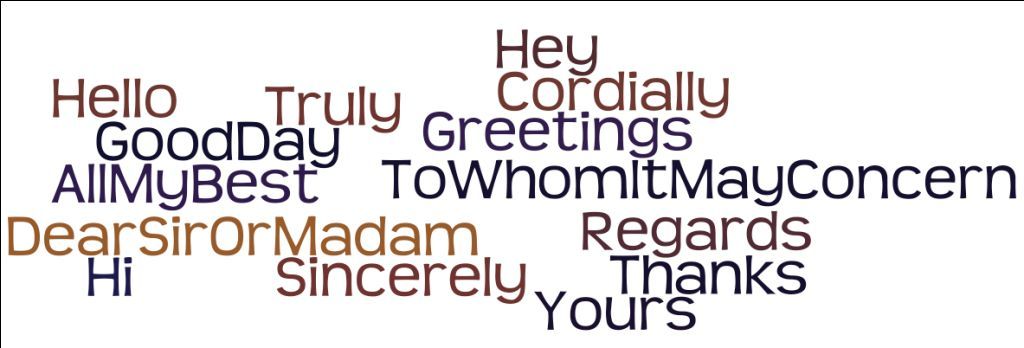
The end of a business email is nearly as important as the email itself. This is due to its significant impact on how the recipient responds. While your email subject and opening create the initial impression, the closing and sign-off shape the type of reply you receive. You certainly don’t want your business email closing to weaken the message of your email.
Also, the content and layout of the information in your sign-offs are crucial and strategic. You should always strive to make it easy for others to reach you by including all your key contact details, especially in initial emails. When reaching out to a potential client, business partner, or associate for the first time, you should offer alternative contact options in your closing. This should include your phone number, email, website, etc.
Different Ways to End Business Emails
Different people have their preferred ways of ending professional emails. Some people like to simply close with Thank you and then sign off their name. Some end by reminding their recipients to take action on the emails or by reminding them of the main thrust of the emails.
Common Business Email Closings
Let’s consider some of the more common business email closings:
1. Email Closing Showing Anticipation and Concerns
Some people like to end their emails with an expression of the action expected from the recipient. They believe this will commit the recipient to take action on the email. This method is very much acceptable in business.
Between business partners or entrepreneur to venture capitalist:
Looking forward to discussing the proposal at the dinner.
Business owner to client:
Do not hesitate to contact me if you have any concerns.
Manager to secretary:
Looking forward to receiving the minutes of the meeting.
2. Business Email Closing Expressing Appreciation
Closing a business email by showing appreciation is a nice way to end an email. Just like in our everyday life, people like to be appreciated. Aside serving as a closing, this kind of closing also leaves the recipient feeling good.
Thanks again,
Ayo Oyedotun
Thank you for letting know you will be available.
Ayo Oyedotun
I truly appreciate this gesture.
Ayo Oyedotun
3. Professional Email Closing Requesting for Action
This kind of closing seems rather straightforward. From the examples below, you will see that this kind of closing shows there is little or no relationship between the sender and the recipient. This is the type of closing you would expect from a choleric or a melancholy; but there is nothing wrong with closing like this.
Recruiter to a job seeker:
Please reply to this message to confirm that you accept our new offer.
Supervisor to student:
Please contact me for a proper review of your project proposal.
HOD to student representative:
Please contact me to discuss the timetable for next semester.
4. Signing Off with Considerations
When you use any of the closings (1 to 3) above, it is nice to also sign-off with a consideration even though it is not compulsory. Most people eventually jump this step after a few seconds of mulling over the right consideration to use. However, the most important thing is to ensure the consideration you choose is based on your level of familiarity with the recipient.
In most business settings, it is fine to sign-off with:
“Yours faithfully” [very formal, good for first time contact emails]
“Kind regards,” [formal, okay for second time contact emails]
“Warm regards,” [personal and professional, okay for subsequent email interactions]
“Yours truly,” [very personal, okay for regular clients]
“Regards,” [personal, okay for second time contact emails]
“Sincerely,” [personal, okay for regular clients]
“Yours sincerely” [personal, okay for regular clients]
“All the best” [personal, okay for regular clients]
4 Things You Should Know About Business Email Closings and Sign Offs
Before you make your choice of closing and/or sign-off to use, there are a couple of things you should know about ending professional emails:
1. How you close your email should be in tandem with the message of the email. It will be awkward to close a nasty email to a debtor with Cheers or All the best.
2. Your closing should include your name (full name for first time contact emails), even if you don’t have time to include other details like job title, contact information and website. For some people, these are already part of their email signature. Also avoid those huge signatures or advertising banners.
Normally, your business email closing should be in this order:
Best wishes,
Ayo Oyedotun
Editor-in-Chief
Woculus Inc.
234-805-392-8069 ext. 12
http://woculus.com/
After your consideration, jump a line and write your full name followed by your contact details. Your official email address should be included if you are emailing from a personal email address.
3. Your closing should remind the reader of the main thrust of your message and, at the same time, show your pleasure in communicating with the recipient.
4. Business email closing should also leave the recipient feeling good about you. This is where your choice of consideration also comes into play.
Below are other considerations you can use in closing your emails. Be sure to select one that fits your message.
- Best
- Cordially
- Cheers
- Best
- Cheers
- Yours
- Kindest regards
- Warmest regards
- I remain yours truly
- Warmly
- Take care,
- Have a great day!
- Happy Holidays!
- Enjoy your weekend!
- Keep up the good work!